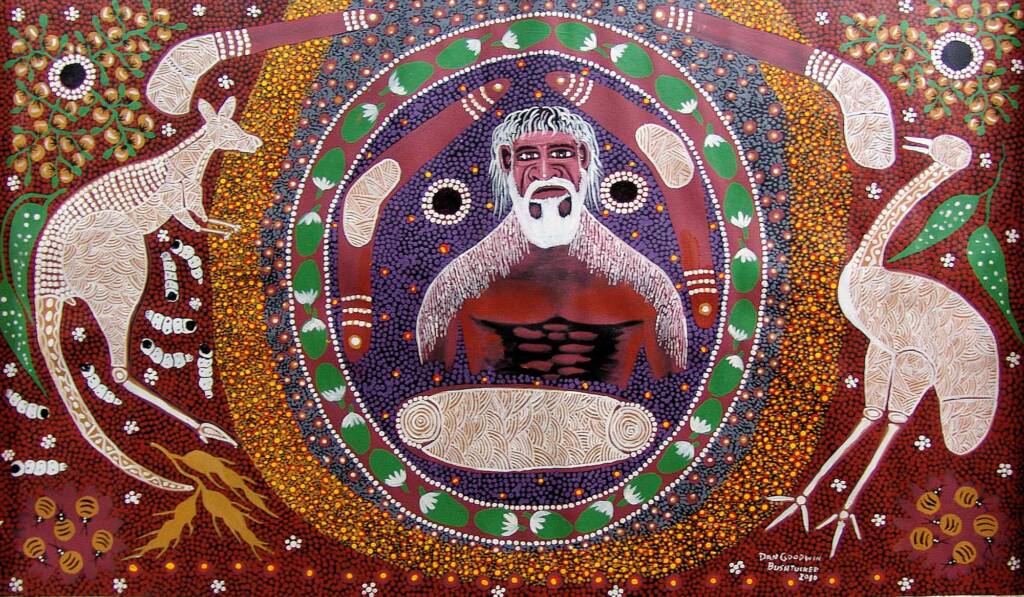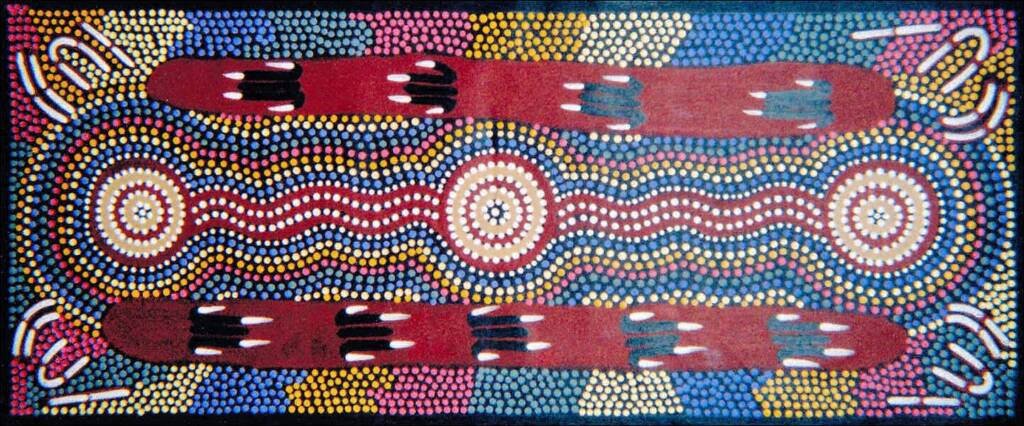Aboriginal Symbols of Fauna and Wildlife
| WARNING: Aboriginal and Torres Strait Islander people are warned that this website contain images, voices and names of people who have passed away. |
Indigenous Symbols, Iconography and Imagery
- Aboriginal Symbols
———————————— - Man Woman Child
- Human Activity
- Tools & Weapons
———————————— - Bush Food
- Bush Medicine
- Wildlife
- Emu
- Goanna
- Honey Ant
- Kangaroo
- Thorny Devil
- Witchetty Grub
————————————
- Landscape & Country
- Rain & Water
————————————
The iconic kangaroo has an important place in Aboriginal art and culture. Appearing in dreaming stories, totems and continued to be used as a food source and for their pelts.
Appearing in Aboriginal art in various symbols and forms, from track marks across the sand, x-ray style depiction and cave paintings that date back thousands of years, the kangaroo has songlines and dreamings stretched across Australia.
Popular in aboriginal paintings, it appears as the central dreaming story of the artwork, in hunting scenes, sometimes painted in a realistic form or depicted as tracks across the canvas, or as part of the ‘bush tucker’ narrative of artworks.
In the depiction of the kangaroo, many artist stamp their own unique way of portraying the animal, whether it is just showing the tracks left by the animal or as the flattened outline or three dimensional form. The kangaroo also appear in animal carvings

As in the stylised kangaroo tracks above, Aboriginal depiction of kangaroo moving through the land, reflect the real life tracks often left in the sands as they pass by.

Some paintings of kangaroos that tell the dreamtime stories are depicted in a more recognisable image, as outlines of the animal, or in x-ray like forms, often stylised.
Animals play a significant part in Indigenous culture, whether it is a totemic relationship, and part of a dreaming, or as food. Their appearance in the artwork of Aboriginal artists goes beyond the physicality of being just bush tucker, and can often reference ceremonial dreamtime and other stories, being a bit player in the artwork or the primary subject, as when painting the ‘Kangaroo Dreaming’.
Cave Paintings / Rock Engraving
There are many examples (much can be researched online) of Aboriginal rock engravings and cave paintings that depict the kangaroo and related family members.

Rock engravings are found across the continent of Australia and even on some of the outlying islands. Burrup Peninsula and Dampier Archipelago is internationally famous for the number of rock art dating back to approx. over 40,000 years old, with the region containing up to 1 million rock art images.
Engravings at Terrey Hills in northern Sydney. The two kangaroos suggest this was used for an “increase ceremony”, whilst the man may be Baiame (in the south-eastern Australian Aboriginal Dreaming, Baiame is the creator).1
The X-ray style of rock art can be found in caves and on rock shelters in the Northern Territory and Western Australia.
In the following artwork by Dan Goodwin (Tjinta Tjinta), titled The Aborigines lived on bush tucker for thousands of years, Dan paints honey ants, wild banana, wild tomatoes, witchetty grubs, wild yam, gum on leaf, emu and kangaroo. Different to his x-ray style of painting a kangaroo, the artist has used a minimal colour range for the kangaroo and other select elements within the painting. Also within the painting are depicted the entrances to goanna burrows.


Check out our fauna section on the Kangaroo, Wallaroo, Euro, Wallaby.
Footnote & References
- Mosaic image of the Rock Engravings at Terrey Hills, NSW, Australia Photograph taken by Ray Norris and Barnaby Norris Hi-res version available on http://www.atnf.csiro.au/people/rnorris/SydneyRockArt/sites/TerreyHillsHunt/index.htm
- Australian Geographic – Burrup Peninsula rock art among world’s oldest, By Jude Dineley, 18 April 2013, https://www.australiangeographic.com.au/news/2013/04/burrup-peninsula-rock-art-among-worlds-oldest/
- SBS Discover – Hidden history: Aboriginal rock art in the Kimberley amongst the oldest in the world, by Nicola McCaskill, 16 Sep 2016, https://www.nationaltrust.org.au/wp-content/uploads/2017/01/20060920-Dampier-Rock-Art-ROE35.pdf
- The header image is from the painting “This is a story of me and menney others…” (extract from artwork) by Dan Goodwin, 2008
